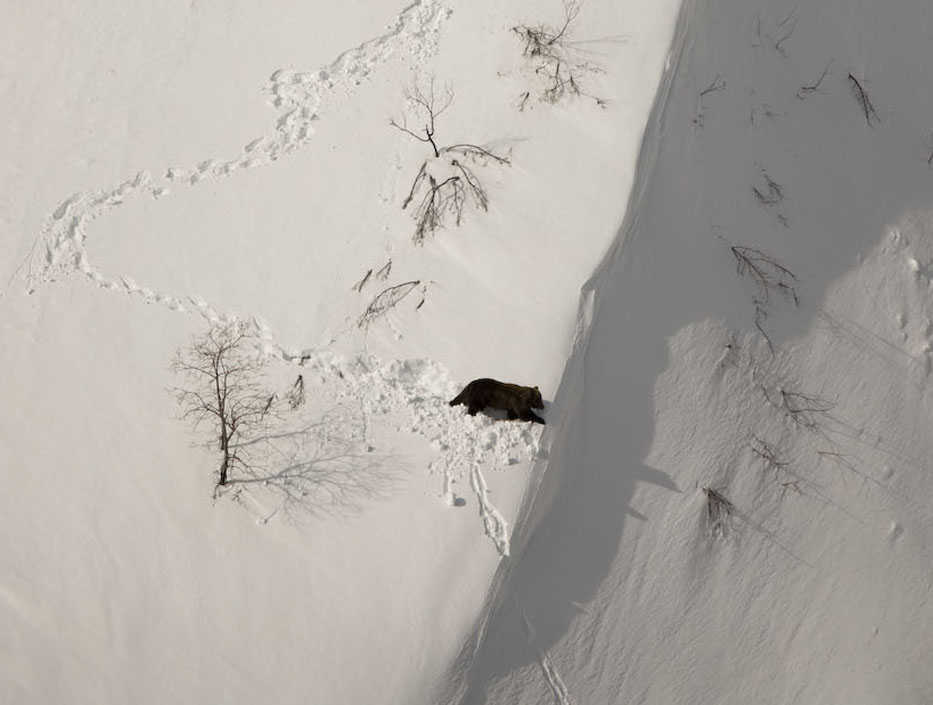Last week, during yet another winter meltdown on the Kenai Peninsula, I heard three stories about bears on the prowl. There was a guy in Homer who managed to chase off a subadult brown bear with bear spray, reports of several bears roaming Anchorage ’burbs, and an observation by a refuge colleague on the Alaska Peninsula of a brown bear over a moose kill. So what woke up the bears?
It’s easy to surmise that the mild weather had some bearing (no pun intended) on why the bears woke up in mid-February. I can only imagine that the absence of snow as insulation from both cold and external sounds might roust a bear. But I also think the rain was a likely culprit as well.
Years ago, when I was younger and much more foolish, I measured the dimensions of grizzly bear dens high in the Brooks Range. We did it later in the summer, long after the bears had left their dens but, in hindsight, it sure seems that encountering, say, a wolverine in a blind cul-de-sac could have been a bad thing. But I remember that some dens were dry and some were wet. It seemed to me even then that a cold wet drip in a dark hole would wake even the sleepiest of bears.
At the end of the day, I couldn’t find anything in my quick search of online literature to indicate what actually makes a bear leave its den in the middle of winter, even a relatively warm and mostly snowless one like we are having now. It may be that each case is unique, and there is no larger pattern. During the winter of 1997-98, brown bears were disturbed at two dens by field workers involved in seismic exploration of leased areas on the Kenai National Wildlife Refuge for underground oil and gas reserves. In a January disturbance, a sow and cub fled their den. In the other disturbance in February, a single brown bear ended up fatally injuring a seismic worker before fleeing the area.
Not to diminish the tragedy, the events do beg the question of how do bears that spend more than half their year in a den spring to life at the drop of a hat? Consider that Astronaut Scott Kelly, who just returned from nearly a year in space, needed help getting out of his space capsule and will likely have brittle bones, weak muscles and a smaller heart. While admittedly in zero gravity, he was also active and exercised during a period that translates to 1/70th of his expected 70-something-year lifespan. A bear not only spends about 1/70th of its 35-year lifespan mostly sleeping in a small capsule-like den in any given year, it does this EVERY year, and yet it still manages to not lose muscle tone or bone calcium.
Researchers from the University of Alaska Fairbanks published an interesting study in the journal Science in 2011 on what happens to a bear’s vital signs during hibernation. They found that despite lowering their metabolism by 75 percent and its heart rate from 55 to as few as 9 beats per minute, black bears maintained their body temperature within a few degrees of normal (90 degrees). As an aside, at least one of their study subjects was a black bear from the Kenai Peninsula.
And despite not eating, drinking, urinating or defecating for five to seven months of the year, they don’t lose mineral content or muscle mass, producing water and up to 4,000 calories per day from the breakdown of body fat. Dr. Brian Barnes, a coauthor of this study, commented that “they’re a closed system — all they need is air, and they can do just fine”.
The muscle and organ tissues of bears also breakdown to supply amino acids and proteins. We do the same thing when we’re starving except that our bodies don’t restore muscle and organ tissue. Bears are somehow able to recycle the nitrogen in urea to build new protein while not allowing it to become toxic as it does in humans.
While bear biology is remarkable, none of this explains why bears wake up in the middle of winter. However, the UAF study found that after emerging from dens, bears maintained their reduced metabolic rates for up to three weeks even as their temperatures returned quickly to normal. My take on this is that a bear encountered in mid-winter in Alaska is probably not hungry. But don’t bet on my opinion — avoid fresh bear tracks in snow, or carry bear spray if you insist on walking or skiing in their tracks.
Dr. John Morton is the supervisory biologist at Kenai National Wildlife Refuge. Find more information at http://www.fws.gov/refuge/kenai/ or http://www.facebook.com/kenainationalwildliferefuge.

